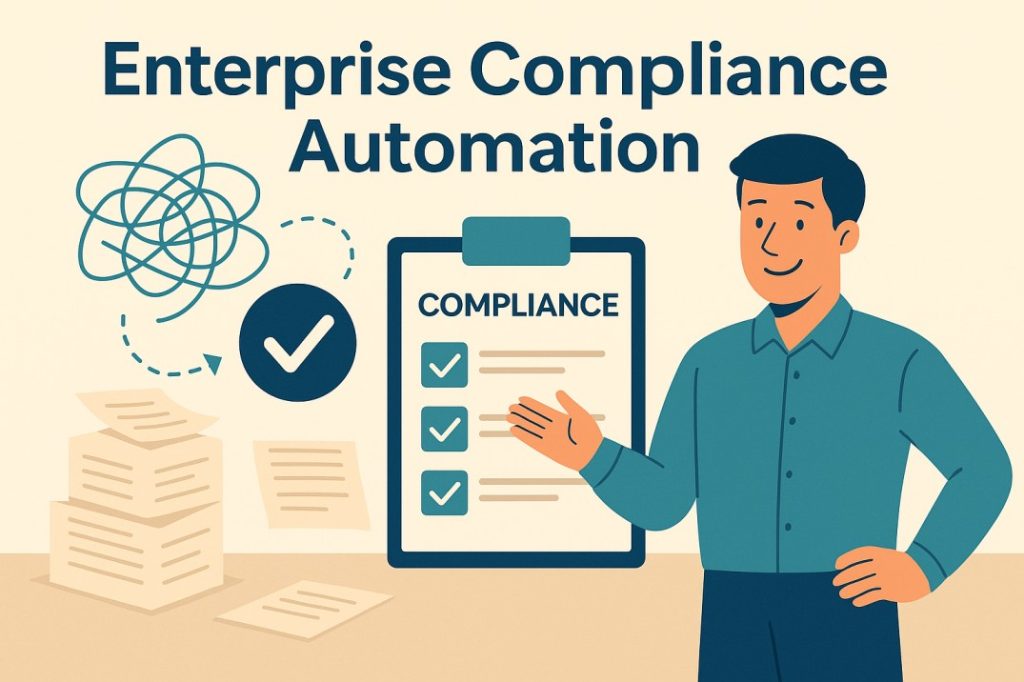For most enterprises, compliance is a dreaded word. It means hours of staff time spent collecting data, chasing documentation, and preparing for audits. Compliance is often seen as a burden—a cost of doing business rather than a driver of value.
But in 2025, automation is rewriting that story. Enterprises that embrace compliance automation are not only reducing risk and saving money; they’re turning compliance into a competitive advantage.
The Weight of Manual Compliance
In a global enterprise, compliance spans everything from financial reporting to data privacy, ESG disclosures, health and safety, and sector-specific regulations. PwC estimates that compliance costs enterprises between 5% and 10% of revenue, much of it spent on manual processes.
Manual compliance typically involves:
- Staff chasing paperwork across departments and geographies.
- Auditors demanding evidence that takes weeks to collate.
- Duplication of data entry into multiple reporting formats.
- High error rates that create risk exposure.
The result? Sky-high costs, regulatory risk, and opportunity costs as teams spend time on admin instead of strategy.
Automation Changes the Game
1. Audit-Ready Data
Automated compliance platforms generate and store evidence in real time. Instead of weeks preparing for an audit, enterprises can produce reports instantly. PwC found that automation cuts audit prep time by up to 50%.
2. Reduced Human Error
By automating document generation and approvals, enterprises reduce error rates and maintain consistent compliance records across multiple jurisdictions.
3. Continuous Monitoring
AI-powered systems monitor transactions and workflows continuously, flagging anomalies before they become breaches. This turns compliance from reactive to proactive.
4. Global Consistency
Enterprises operating across borders can use automation to standardise compliance processes. This reduces regional discrepancies and ensures every team works to the same standard.
5. Competitive Differentiation
Strong compliance isn’t just about avoiding fines—it builds trust. Customers, investors, and partners prefer to work with enterprises that demonstrate transparency and accountability. In highly regulated industries, compliance automation becomes a selling point.
From Pain Point to Performance Driver
Consider a multinational healthcare provider grappling with patient data privacy across five regions. Manual compliance consumed thousands of staff hours annually. By implementing automated compliance workflows:
- Data collection became centralised and auditable.
- Reports for regulators were generated automatically.
- Staff were freed to focus on patient care instead of paperwork.
Within a year, compliance costs fell by 35%, regulatory risk plummeted, and customer trust improved. What was once a pain point became a differentiator.
The Path to Automated Compliance
Enterprises don’t need to automate everything at once. A phased approach works best:
- Map Compliance Processes — identify high-friction areas (audit prep, document management).
- Standardise Data — create a single source of truth across departments.
- Introduce Automation Tools — automate document generation, approvals, and monitoring.
- Scale Across Regions — roll out standardised workflows globally.
- Leverage Analytics — use dashboards to measure compliance performance and risk trends.
The Bottom Line
Compliance will always be mandatory—but it doesn’t have to be a burden. With automation, enterprises can reduce costs, lower risks, and transform compliance into a source of trust and competitive strength.
In an era where customers, investors, and regulators demand transparency, compliance automation is no longer optional. It’s an enterprise advantage waiting to be unlocked.

